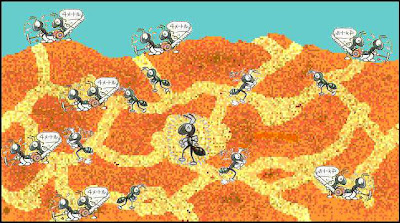Últimos assuntos
Tópicos mais visitados
Tópicos mais ativos

Vai ter com as formigas..., oops, pesquisa científica revela divisão de trabalho entre as formigas
Página 1 de 1
27042011

 Vai ter com as formigas..., oops, pesquisa científica revela divisão de trabalho entre as formigas
Vai ter com as formigas..., oops, pesquisa científica revela divisão de trabalho entre as formigas
Vai ter com as formigas..., oops, pesquisa científica revela divisão de trabalho entre as formigas
Ants in a Labyrinth: A Statistical Mechanics Approach to the Division of Labour
Thomas Owen Richardson1,2*, Kim Christensen3,4, Nigel Rigby Franks2, Henrik Jeldtoft Jensen3,5, Ana Blagovestova Sendova-Franks1
1 Department of Engineering, Design and Mathematics, University of the West of England, Bristol, United Kingdom, 2 School of Biological Sciences, University of Bristol, Bristol, United Kingdom, 3 Institute for Mathematical Sciences, Imperial College London, London, United Kingdom, 4 Department of Physics, Imperial College London, London, United Kingdom, 5 Department of Mathematics, Imperial College London, London, United Kingdom

Image not related to this article/Imagem não relacionada com este artigo
Source/Fonte
Abstract
Division of labour (DoL) is a fundamental organisational principle in human societies, within virtual and robotic swarms and at all levels of biological organisation. DoL reaches a pinnacle in the insect societies where the most widely used model is based on variation in response thresholds among individuals, and the assumption that individuals and stimuli are well-mixed. Here, we present a spatially explicit model of DoL. Our model is inspired by Pierre de Gennes' 'Ant in a Labyrinth' which laid the foundations of an entire new field in statistical mechanics. We demonstrate the emergence, even in a simplified one-dimensional model, of a spatial patterning of individuals and a right-skewed activity distribution, both of which are characteristics of division of labour in animal societies. We then show using a two-dimensional model that the work done by an individual within an activity bout is a sigmoidal function of its response threshold. Furthermore, there is an inverse relationship between the overall stimulus level and the skewness of the activity distribution. Therefore, the difference in the amount of work done by two individuals with different thresholds increases as the overall stimulus level decreases. Indeed, spatial fluctuations of task stimuli are minimised at these low stimulus levels. Hence, the more unequally labour is divided amongst individuals, the greater the ability of the colony to maintain homeostasis. Finally, we show that the non-random spatial distribution of individuals within biological and social systems could be caused by indirect (stigmergic) interactions, rather than direct agent-to-agent interactions. Our model links the principle of DoL with principles in the statistical mechanics and provides testable hypotheses for future experiments.
Citation: Richardson TO, Christensen K, Franks NR, Jensen HJ, Sendova-Franks AB (2011) Ants in a Labyrinth: A Statistical Mechanics Approach to the Division of Labour. PLoS ONE 6(4): e18416. doi:10.1371/journal.pone.0018416
Editor: Enrico Scalas, Universita' del Piemonte Orientale, Italy
Received: November 11, 2010; Accepted: March 4, 2011; Published: April 25, 2011
Copyright: © 2011 Richardson et al. This is an open-access article distributed under the terms of the Creative Commons Attribution License, which permits unrestricted use, distribution, and reproduction in any medium, provided the original author and source are credited.
Funding: TOR and ABS-F acknowledge EPSRC grant EP/E061796/1. KC acknowledges EPSRC grant EP/E061761/1. The funders had no role in study design, data collection and analysis, decision to publish, or preparation of the manuscript.
Competing interests: The authors have declared that no competing interests exist.
* E-mail: tom.richardson@bristol.ac.uk
+++++
FREE PDF GRATIS
Ants in a Labyrinth: A Statistical Mechanics Approach to the Division of Labour
Thomas Owen Richardson1,2*, Kim Christensen3,4, Nigel Rigby Franks2, Henrik Jeldtoft Jensen3,5, Ana Blagovestova Sendova-Franks1
1 Department of Engineering, Design and Mathematics, University of the West of England, Bristol, United Kingdom, 2 School of Biological Sciences, University of Bristol, Bristol, United Kingdom, 3 Institute for Mathematical Sciences, Imperial College London, London, United Kingdom, 4 Department of Physics, Imperial College London, London, United Kingdom, 5 Department of Mathematics, Imperial College London, London, United Kingdom

Image not related to this article/Imagem não relacionada com este artigo
Source/Fonte
Abstract
Division of labour (DoL) is a fundamental organisational principle in human societies, within virtual and robotic swarms and at all levels of biological organisation. DoL reaches a pinnacle in the insect societies where the most widely used model is based on variation in response thresholds among individuals, and the assumption that individuals and stimuli are well-mixed. Here, we present a spatially explicit model of DoL. Our model is inspired by Pierre de Gennes' 'Ant in a Labyrinth' which laid the foundations of an entire new field in statistical mechanics. We demonstrate the emergence, even in a simplified one-dimensional model, of a spatial patterning of individuals and a right-skewed activity distribution, both of which are characteristics of division of labour in animal societies. We then show using a two-dimensional model that the work done by an individual within an activity bout is a sigmoidal function of its response threshold. Furthermore, there is an inverse relationship between the overall stimulus level and the skewness of the activity distribution. Therefore, the difference in the amount of work done by two individuals with different thresholds increases as the overall stimulus level decreases. Indeed, spatial fluctuations of task stimuli are minimised at these low stimulus levels. Hence, the more unequally labour is divided amongst individuals, the greater the ability of the colony to maintain homeostasis. Finally, we show that the non-random spatial distribution of individuals within biological and social systems could be caused by indirect (stigmergic) interactions, rather than direct agent-to-agent interactions. Our model links the principle of DoL with principles in the statistical mechanics and provides testable hypotheses for future experiments.
Citation: Richardson TO, Christensen K, Franks NR, Jensen HJ, Sendova-Franks AB (2011) Ants in a Labyrinth: A Statistical Mechanics Approach to the Division of Labour. PLoS ONE 6(4): e18416. doi:10.1371/journal.pone.0018416
Editor: Enrico Scalas, Universita' del Piemonte Orientale, Italy
Received: November 11, 2010; Accepted: March 4, 2011; Published: April 25, 2011
Copyright: © 2011 Richardson et al. This is an open-access article distributed under the terms of the Creative Commons Attribution License, which permits unrestricted use, distribution, and reproduction in any medium, provided the original author and source are credited.
Funding: TOR and ABS-F acknowledge EPSRC grant EP/E061796/1. KC acknowledges EPSRC grant EP/E061761/1. The funders had no role in study design, data collection and analysis, decision to publish, or preparation of the manuscript.
Competing interests: The authors have declared that no competing interests exist.
* E-mail: tom.richardson@bristol.ac.uk
+++++
FREE PDF GRATIS

Eduardo- Mensagens : 5997
Idade : 54
Inscrição : 08/05/2010
Vai ter com as formigas..., oops, pesquisa científica revela divisão de trabalho entre as formigas :: Comentários
Nenhum comentário
 Tópicos semelhantes
Tópicos semelhantes» Pesquisa revela que 7% dos católicos não creem em Deus?
» Pesquisa Científica Promove Adventismo
» Oops, a [teoria da] evolução se esqueceu dos eucariotos...
» Formigas matemáticas
» Formigas problemáticas
» Pesquisa Científica Promove Adventismo
» Oops, a [teoria da] evolução se esqueceu dos eucariotos...
» Formigas matemáticas
» Formigas problemáticas
Permissões neste sub-fórum
Não podes responder a tópicos
 Início
Início








 Seja fã Forumeiros
Seja fã Forumeiros
» Acordem adventistas...
» O que Vestir Para Ir à Igreja?
» Ir para o céu?
» Chat do Forum
» TV Novo Tempo...
» Lutas de MMA são usadas como estratégia por Igreja Evangélica para atrair mais fiéis
» Lew Wallace, autor do célebre livro «Ben-Hur», converteu-se quando o escrevia
» Ex-pastor evangélico é batizado no Pará
» Citações de Ellen White sobre a Vida em Outros Planetas Não Caídos em Pecado
» Viagem ao Sobrenatural - Roger Morneau
» As aparições de Jesus após sua morte não poderiam ter sido alucinações?